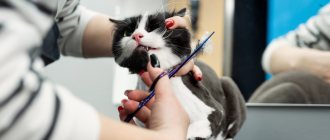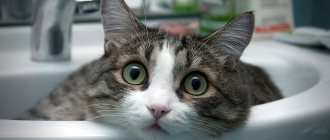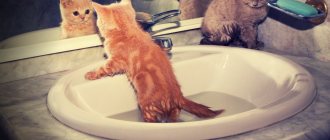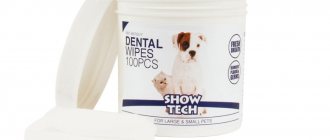All cat owners know that these are very clean animals. After eating or visiting the tray, they carefully lick their coat, and do it very efficiently.
The cat's tongue has a special structure. On its surface there are hard fibers that are located at an angle. Therefore, licking can be compared to combing with a fine-toothed comb. The cat's fur is treated with natural lubricant, which makes the fur coat attractive. When bathing, the balance is disrupted, so frequent water treatments are contraindicated for your furry pet.
Every owner understands that the animal needs to be bathed periodically, but not everyone knows how often this can be done. This procedure is recommended only in certain cases:
- in case of contamination, if the animal is walking on the street;
- once every six months to improve the appearance of the coat;
- It is necessary to bathe the cat from fleas and when infected with parasites (using special means).
But how to bathe a cat if he is afraid of water? Yes, these clean people actually have a very negative attitude towards water procedures (with the exception of some breeds). Nevertheless, sooner or later you have to resort to them. In this article we will try to tell you how to properly bathe a cat so as not to turn this process into torture for you and for the animal.
Owners need to know that the animal is accustomed to all hygiene procedures (including bathing) from a young age. Otherwise, any manipulation related to hygiene will cause a violent protest on the part of your pet.
How to bathe a cat for the first time?
So, we found out that your cat should first become acquainted with water and shampoo at a young age. It should be remembered that a kitten has a vulnerable child’s psyche. The owner’s task is not to instill in the baby a persistent aversion to water and the entire procedure as a whole. To do this, you must follow some rules. The baby’s attitude towards this procedure in the future depends on the very first bath.
A kitten should be accustomed to water from three months. Usually, before this age, his mother washes him out. However, there are exceptions to every rule. If a kitten is very dirty at the age of one month, then it can and should be bathed. You should not carry out the first procedure in the bathroom. A basin is more suitable for this, as it doesn’t look as intimidating to a baby as a huge white bathtub, and it will also be easier to keep him in the water.
You need to pour a little water so that it just reaches the kitten’s tummy. While bathing, talk to your baby in a quiet voice and call him by name. Do not wet the kitten's head from the shower; clean the fur on it with a sponge. Use shampoo for kittens, choosing it based on your pet's coat type. If you can’t purchase it, use any children’s one.
At what age can you bathe a kitten?
Kittens are more vulnerable than adult animals. Their immunity is still developing, so you shouldn’t risk bathing your pet too early. During washing, the temperature regime is disrupted and the fatty film that protects the baby from pathogenic bacteria is washed off.
There is no need to bathe kittens for the first 2 months after birth. The mother takes care of their hygiene. However, many breeders wash kittens as early as 1 month. This is due to the fact that they prepare animals for sale and try to provide the kids with the most attractive appearance.
In case of severe contamination, you can carefully wash a one-month-old kitten, but only if it is accustomed to its owners and has become comfortable in the apartment. If possible, it is better to limit wiping with a damp cloth.
At 3 months, when the kitten is stronger, you can start bathing it without harm to its health. There is no need to postpone the procedure. The sooner the baby gets acquainted with water, the sooner he will get used to it.
As for at what age you can bathe a kitten with flea shampoo, it largely depends on its brand. Typically, such drugs are not used for up to two months.
However, some mild flea shampoos can be used a little earlier. It is better to consult a veterinarian first and carefully study the instructions.
How to bathe an adult cat?
If you have not taught your pet to bathe from a young age, then this procedure becomes much more complicated. However, do not think that your attempt is doomed to failure. Below we will present you with tips and recommendations from experienced owners and veterinarians who will certainly answer the question of how to bathe a cat without scratching it.
To bathe an adult animal, use dry or liquid shampoos for cats; in rare cases, it is allowed to use shampoo for people, as well as baby soap.
How to wash representatives of different breeds
Representatives of different breeds require a special approach to bathing:
- Shorthaired Scots and Britons who devote a lot of time to grooming can be bathed once every six months.
- Long-haired cats, such as Persian or Siberian cats, need to be washed every 2 months.
- White kittens are bathed with whitening shampoos.
- Detergents for long-haired breeds are not used for short-haired kittens with abundant undercoat.
- It is not advisable to bathe kittens of white and blue colors, particolors and silver pets with herbal shampoos.
- To wash Sphynxes and other hairless cats, specialized shampoos are used that care for the skin. The head is wiped with sanitary napkins.
- Products for adding volume are not suitable for animals with tight-fitting hair without undercoat (Siamese, Oriental, Abyssinian cats, etc.).
Cleansing with dry shampoo
This is the simplest, most gentle way. What are its advantages over the traditional one? Using dry shampoo will not make your cat nervous, and your hands will remain intact.
You can use this product once every six months. In this case, the procedure will not become more complicated than regular combing. But you should know that if it is carried out on a carpet, then it will be quite difficult to clean it from the powder. After rubbing the shampoo a little into the animal's fur, comb it thoroughly.
Circumstances for washing a cat
There is no need to force an animal without special prerequisites. The process is stressful for most pets and it is not worth causing them excessive nervousness - hygiene can cause behavioral disturbances.
Heavy pollution
How often can you wash your dog and puppy with shampoo?
Should pet cats be washed if they look dirty? The prerequisites for care activities are:
- increased soiling of wool and its matting - due to the active production of sebum;
- period of hormonal imbalance during sexual heat - the pet rolls on any surface, collecting dirt;
- accidental ingestion of fatty, oily substances that the cat cannot remove on its own.
Presence of parasites
If blood-sucking parasites are detected, washing is carried out with special insecticidal zoo shampoos. They help quickly get rid of fleas and prevent scratching of the skin when bitten. In case of severe infection, the procedure is carried out twice.
Important! Additional treatment involves the use of anti-parasite sprays or drops, which are left for 24-48 hours, after which the pet is bathed again.
Particular attention is paid to the British - they often suffer from allergies, and medications must be selected for them by a veterinarian.
Before exhibitions and competitions
Is it possible to bathe cats before an exhibition or competition? Participation in exhibition events requires the ideal condition of the coat. On the eve of the competition, zoo shampoos are used to give the cover shine and silkiness. The wool is combed, applied with gel and varnish.
Another interesting question: is it possible to wash a purebred cat with human herbal shampoo? Experts are unanimous on this issue - the use of inappropriate care products can cause massive hair loss and partial baldness of the pet. Injured animals are not allowed to exhibit.
Spray shampoo
Once for a certain period
Some owners set their own schedule for hygiene procedures and, for example, prefer to carry them out once a quarter, on a certain day. This approach allows you to avoid problems with the sebaceous glands and drying out your pet’s skin.
Important! Using tar or laundry soap can cause dermatoses and rashes, and dulling of the coat. Animals are not suitable for human remedies.
Is it possible to wash a cat after giving birth?
Should cats be washed during the postpartum period? You should not bathe a nursing animal without objective reasons:
- getting oils and fuel oil on the fur;
- accidental contact with fresh paint;
- damage by blood-sucking parasites.
Cleaning-induced stress can affect the quantity and quality of breast milk in both British and non-bred mothers. The owner will have to switch to artificial feeding of the babies.
Preparing for a swim
First of all, trim the cat's claws, this will protect your hands from deep and rather painful scratches. Brush the fur a little so that it doesn't get too tangled during bathing. This is especially important for long-haired animals. All matted wool is cut off if it cannot be untangled.
If a small amount of water is enough to bathe a kitten and you can get by with a basin, then what about an adult animal, which can sometimes be quite impressive in size? Keeping it in a small container is much more difficult; besides, it costs nothing for an adult and strong cat to turn the basin over. How to bathe a cat in the bathroom so that he doesn’t run away during a procedure he hates so much?
The first thing you need to do is protect your pet's ears. To prevent water from getting into them, put a cellophane cap on his head. Place a terry towel on the bottom of the bath so that your pet does not slip and feels at least a little more confident. There should be enough water so that it is just above the animal’s belly.
When starting to bathe your cat, turn off the water, as its noise additionally frightens the cat. Another important factor is water temperature. It should be slightly warm. Dip your elbow into it - it should not burn your skin. When bathing a one-year-old cat for the first time, you expose him to enormous stress, which will be very difficult for one person to cope with. In this case, at least two people will be able to hold it, since the frightened animal screams, breaks out, and scratches. It’s better to do this together, then one person holds the cat and the other washes it.
If you know your pet is too nervous, bathing becomes an additional challenge. In this case, how to bathe the cat? At this moment he scratches and even bites mercilessly. In this case, veterinarians recommend giving him a special cat sedative before the procedure. However, you should not abuse it.
How to teach a kitten to bathe
Bathing is a serious stress for your pet. To avoid health problems and not to injure the baby’s psyche, he needs to be prepared before the first wash.
Important. Kittens subtly sense people's moods. If the owner is nervous, the anxiety will be transmitted to the pet. Therefore, before swimming you need to calm down and relax.
First, the kitten is placed in a dry bath and they try to play with it. He needs to understand that it is safe here. When the baby gets comfortable, open the tap. Some pets themselves show interest and begin to play around with a thin stream of water.
The process is repeated several times until the kitten becomes absolutely calm about the procedure. Cats that cannot get used to water can be bathed in mesh bags. They restrict the movement of animals, but do not prevent water and detergents from entering the body.
How is bathing carried out?
Before putting your cat in the bath, remove all unnecessary objects (towels, washcloths, jars, bottles, etc.) that he could get caught on. Prepare a towel in advance and open the shampoo. Place the cat in the bath, pet him, but hold him tightly, even if he tries to escape. These animals are very cunning, and as soon as your pet feels that your grip has weakened a little, he will immediately make a quick dash and run away.
Do not delay bathing, do not overdo it with the amount of detergents and the intensity of their rubbing. This animal doesn’t have so much fur that it needs to be dealt with in the bathroom for half an hour, and the more thorough the bathing, the more time it will take to bring the natural balance back to normal. Bathing should take no more than 5-10 minutes.
How to bathe a cat without water and shampoo getting into his nose, eyes or mouth? It’s very simple - don’t wash his face. He can handle this job himself just perfectly. Apply shampoo to the cat's back and rub it well. Stand the animal on its hind legs and apply it to the chest, belly, front legs and tail. Lather the shampoo with your hands. It is necessary to wash it off only from top to bottom, and this must be done carefully, because when the cat licks the fur after bathing, it can be poisoned by its residues. Wrap the animal in a towel and hold it in your arms to calm it down a little.
Basic rules for washing kittens
It is better to keep the doors to the bathroom closed, because if the cat runs away from you, you will not need to look for it throughout the apartment.
It is necessary to wash the cat with confident movements, which include:
- The most important point is to place the animal in the bath; it is better to grab it by the scruff of the neck, so that it does not have the opportunity to scratch, break free and run away. Before you start washing the kitten, you need to wet its fur and keep its nose and ears dry. To avoid irritation, you should put eye drops in your pet's eyes and plug his ears with a tampon. Water should not get into the cat’s nose and ears, otherwise inflammatory processes may occur.
- It is most convenient to wash a kitten in the shower; this procedure will result in less splashing, and the animal will more easily endure such an ordeal. You can hold the cat with your left hand, and the shower with your right.
- The shower must first be put aside, and the shampoo must be applied to the back, paws and tummy of the pet, do not forget about the tail.
- Last but not least, you can wash the baby’s head, because this is the most unpleasant part of this procedure.
- A soft sponge should be used for washing.
- The easiest way to wash off the foam is with a shower from top to bottom, but you need to make sure that water does not get into the cat’s ears.
- After the pet has taken a bath, all the foam has been washed off, it must be placed in a warm towel. It is best to use two towels, and one of them must be thick, because it is unknown how the cat will behave after washing.
- You should not bathe your pet after he has eaten. The bath should be used no earlier than 4 hours after eating.
If the kitten has survived vaccination, then it will be possible to wash it no earlier than after 2 weeks.
Flea shampoo
When keeping a cat, great attention should be paid to the regular extermination of fleas. For adult animals, this is much easier to do than for a kitten: you can wear flea collars or use external drops once a month. But such products are not recommended for use on kittens - for them, the dose of chemicals may be toxic.
The most practical and most effective way to rid your baby of fleas is to bathe him with a special shampoo. Depending on the strength of the shampoo, the animal may need to be re-treated. As a rule, clear recommendations are indicated on the packaging of the product. Remember that you should not wash your cat for no apparent reason. She should only be bathed if she is really dirty.
How to wash a cat
The condition of the animal's skin is greatly influenced by what you bathe the cat with. This should be a special pet shampoo that best suits the type and length of the coat.
Breeders recommend professional products. Their advantages:
- no flavorings;
- natural composition;
- improve the quality of wool and allow you to wash away dirt well.
If there is no special shampoo and the cat needs to be washed, in exceptional cases and once it is permissible to use shampoo for children under 3 years of age.
Is it possible to wash a cat with regular shampoo?
Cats have drier skin than humans. Therefore, you cannot bathe a kitten or an adult animal with either baby soap or human shampoo. Using regular shampoo will dry it out, which may result in hair loss.
You should also not wash your cat with laundry soap. The product changes the state of the microflora of the skin and dries it out. From such experiments, the coat becomes dry, dull, and allergies may develop.
Shampoos for other animals are not suitable either. Detergents, for example, for dogs can cause serious allergies in cats even after the first use.
What should you not do while swimming?
As you can imagine, bathing a cat, a procedure that takes only a few minutes, is quite difficult for both the animal and its owner. Therefore, it is necessary to minimize possible irritants:
- Do not open the tap at full capacity.
- The shower should not be turned on at full power.
- Do not use dog shampoo or dishwashing detergent to wash your pets.
- There is no need to pour shampoo from the bottle directly onto the coat, especially dry hair.
- It is strictly forbidden to stuff the animal's ears with cotton - it can cause serious irritation.
Step-by-step procedure for bathing a kitten
The water procedure must be made as comfortable as possible, because the kitten can be very frightened and in the future the bath will be associated with stress in the animal.
- Step 1. Choose a bathing container: basin, sink, bathtub. The most important thing is that the surface should not be slippery. You can lay a towel or rubber mat.
- Water level. The water should reach the neck, covering the entire body of the animal.
- Comfortable water temperature – up to 40°C.
- Do not make sudden movements or make loud noises.
- Observe the animal’s condition: does the kitten have stress or severe anxiety?
- The room should not be drafty or too hot.
- Step 2. Wet the animal's body, then distribute the shampoo evenly, rubbing in with gentle massage movements. If possible, allow the animal to soak in the shampoo for a few minutes.
- Don't forget to wash the areas at the top of the tail, under the tail, behind the ears, and paws.
- Step 3. It is better to rinse off under low pressure of water. Strong jets can frighten a kitten.
- Step 4. It is better to wet the muzzle with your hands or a sponge.
- Avoid contact of detergents with eyes, ears and mouth. Water getting into the ears can lead to otitis media.
REFERENCE . Otitis is an inflammation of the external auditory canal. Due to excessive moisture, bacteria or fungi begin to multiply in the ear. After bathing, the ears can be cleaned with veterinary lotion, thereby removing excess moisture, if any.
- Step 5. After bathing the kitten, dry it thoroughly with a towel and wrap it in another dry towel. Gradually get used to blow-drying: from the tail, gradually reaching the neck and muzzle.
- Step 6. During the drying process, you need to comb the wool. If there is a tangle, carefully cut it off with scissors.
- Make sure all shampoo or conditioner has been removed from the surface of the animal's body.
ATTENTION . The drug remaining on the skin after swimming can cause poisoning.
Video on how to bathe a kitten and dry it after bathing:
What to do after swimming?
After bathing your cat, you need to dry it thoroughly with a towel, since cats get very cold after such a water procedure, especially if the apartment is not very warm. Many owners consider it lucky if the cat allows him to be warmed in a towel for at least five to ten minutes. Then the animal will most likely break free and begin to lick its coat on its own.
Pre-cover all surfaces where your pet can sit down to lick with towels. They will absorb moisture, and your sofas and carpets will remain stain-free. If your cat continues to tremble violently within five minutes, try to dry it with a hairdryer to avoid catching a cold or even pneumonia.
You already know how to bathe a cat. Now it’s worth talking about combing the fur. When the cat stops licking his fur, pick him up and brush him with a wide-toothed brush. After bathing, the coat becomes very brittle, so combing must be extremely careful.
Contraindications to bath procedures
There are situations when it is absolutely forbidden to bathe kittens. These include:
- Illness - avoid water procedures until complete recovery.
- Vaccination – bathing kittens is prohibited for 14 days after vaccination.
- Ringworm - along with water, the infection will spread to other parts of the body.
- Surgery – After surgery, cats are not bathed until the stitches have healed.
- Severe stress - water procedures will only aggravate the condition.
And a few more tips
- Under no circumstances should you yell at your pet while bathing; remember that he is under extreme stress; calm him down in a quiet voice.
- Rinse the fur very thoroughly after shampoo - low-quality products can be toxic to the animal.
- If the cat gets dirty with something oily, lubricate the spot with butter before bathing, massage it a little and blot it with a paper napkin or towel.
- When removing fleas using a special shampoo, first wet its neck so that they do not run onto the animal's head.
Causes of fear
Fear and aversion to water is a natural cat reaction.
Your pet can and should be bathed. The cause of fear is caused by many factors. This may be an unusual environment, too bright light, noise and shouting of people.
Situation
In the bathroom, the animal's movements are constrained, sounds seem sharp, and the sound of water is frightening. Often the owner shouts at the cat if it behaves too aggressively.
The animal does not like that in the bathroom it cannot gain stability, clinging to its claws, while being forcibly held down.
Reaction to shower and hot water
Water flows out of the shower spray noisily and in large streams, which greatly frightens your pet. The animal perceives the hissing pressure of water as a living aggressive creature.
Fluid temperature is not always adjusted (too cold or too hot). When swimming, these factors should be taken into account first.
How to wash specific body parts
Follow our tips, and you will be able to easily accustom your pet to bath procedures:
- Wash your ears . We recommend reading a more detailed article on how to properly clean a kitten's ears. For this you will need dry cotton pads. Gently wipe the kitty's ear with them. If a little dirt still remains, purchase a special lotion from a veterinary pharmacy. Spread it on a cotton pad and wipe the skin. Or use ear cleaning liquid, which must be poured directly into the sink, and after the dirt comes out, wipe it with a dry cotton swab.
- How to wash a kitten's butt ? In general, it is worth teaching your baby to clean himself. But, if you have not yet succeeded, then use a damp cloth or tampon. You can lightly spray such a place with water, then the cat will probably start licking it himself.
- Wash the kitten's face . For minor stains, a damp cotton pad will help. If spots appear on the chin, which in cats is very vulnerable to various types of inflammation, then use zoo shampoo for bathing.
- How to wash your spout . Only clean visible areas and use cotton swabs. A wet nose should be wiped with a paper napkin.
- How to wash a kitten's paws . After a walk or toilet, place the purr in the washbasin and lightly rinse the bottom of the limbs with warm water.
- Wash the kitten's eyes . Clean them using discs moistened with water. If a kitten has swollen eyes, then they should be wiped with a cotton wool soaked in black tea.
A small basin is enough











